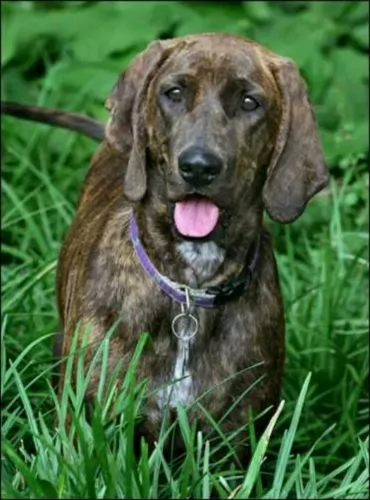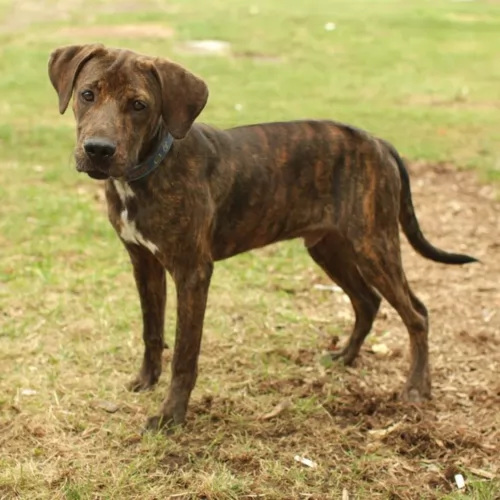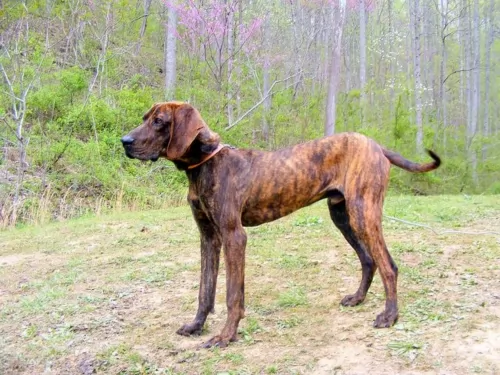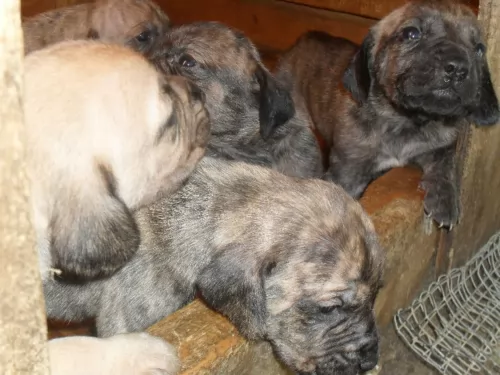 Petzlover
PetzloverPlott Hound is originated from Germany but Sanshu is originated from Japan. Plott Hound may grow 16 cm / 7 inches higher than Sanshu. Both Plott Hound and Sanshu are having almost same weight. Both Plott Hound and Sanshu has same life span. Plott Hound may have more litter size than Sanshu. Both Plott Hound and Sanshu requires Low Maintenance.
 The Plott Hound is a scent hound who has always been used for for hunting bears. The dog may well be the state dog of North Carolina, but it isn’t well known.
The Plott Hound is a scent hound who has always been used for for hunting bears. The dog may well be the state dog of North Carolina, but it isn’t well known.
The Plott Hound is an old dog breed descending from several Hanoverian Schweisshunds which were brought to North Carolina way back in 1750. They were brought by a German immigrant, Johannes George Plott, and that is why it is believed that the dog hails from Germany.
It is believed that in the early 1900s the dog was mated with black-and-tan hounds, giving the canine additional scenting skills as well as its black-saddled brindle pattern. The dog breed has since been registered by the United Kennel Club and is also registered by the American Kennel Club.
The Sanshu was developed in Japan a century ago – in 1912 in fact.
It is a cross between the Chinese Chow Chow and the ancient Japanese Aichi. People who know these dogs say they bear a resemblance to other Inu breeds, but it has a straight tail and not the usual curved one that you'd expect.
The breed is rare and they aren’t recognized by any breed organization.
 The Plott Hound is a large dog standing between 50 and 71cm in height, both male and female, and weighing in at between 18 to 27kg.
The Plott Hound is a large dog standing between 50 and 71cm in height, both male and female, and weighing in at between 18 to 27kg.
The dog’s coat is available in a number of brindle shades such as red-, blue, tan-, brown and black brindle. The ears of the dog are long and floppy and the tail is also long and held up or down, depending on whether the dog is quiet or excited. He is active and would not be recommended for a small homes in the city.
Bold, alert and intelligent, the Plott Hound is a confident, courageous and loyal pet, being somewhat aloof around strangers.
Typical of any hounds, he is a strong willed, independent dog, and this is why he will need training and socialization. These make him obedient so that he can respond to simple commands such as sit, lie down, come and stay. This makes him a pleasure to have around wherever you go with him. He is also protective, making him an excellent watchdog.
The Sanshu is a medium sized dog standing at between 50 to 55cm in height and weighing in the region of 20 to 25kg.
There is also a smaller variety. This dog has a wedge-shaped head with a tapering muzzle, dark almond-shaped eyes with small erect ears. The tail is long and is straight but it can bend over the dog’s back. The coat is short and coarse and can come in a number of shades such as tan, white, reddish, white and black.
The Sanshu is a dog that loves to please its owners. Even so, training and socialization should be given to this dog. He is an intelligent dog, and with training and socialization he becomes well balanced and able to respond to a few commands such as sit, come, stay and lie down.
These are loving, loyal dogs and bond closely with their human family. It is a true companion dog and makes an excellent guard dog too. He makes a great pet with children, if the children have been taught to be kind and gentle to animals and not climb all over them.
 The Plott is a bold, aggressive type of dog, but he is also loving, loyal and intelligent.
The Plott is a bold, aggressive type of dog, but he is also loving, loyal and intelligent.
If you want him as a pet and companion, another bonus part is that his smooth, short coat makes him a low maintenance breed. He’s good looking too, and with training and socialization he’s going to make a great family friend, guardian and pet.
Sanshu dogs are known for the exceptional companionship they offer. They are loving, loyal dogs, wanting to fit in peacefully with their human companions and eager to please.They are amicable dogs, willing to get on well with other dogs in the family too.
In exchange for such devotion, everyone who owns one of these dogs should be eager to ensure they provide well for their 4-legged family member.
 Your Plott Hound is a healthy dog breed and can live to be anything from 12 to 14 years of age. Just like with any other dog breed, they are prone to certain health conditions. It is however, highly unlikely that he will get any of the diseases, but it is good to be aware of some of them -
Your Plott Hound is a healthy dog breed and can live to be anything from 12 to 14 years of age. Just like with any other dog breed, they are prone to certain health conditions. It is however, highly unlikely that he will get any of the diseases, but it is good to be aware of some of them -
There are many forms of cancer and some of the symptoms of the disease include lumps, sores that won’t heal, difficulty with breathing, lack of energy and black stools. Cancer is of course life threatening and treatments will include the likes of chemotherapy, radiation and even surgery.
This is also a deadly disease where parasites infect a dog’s heart and arteries. With a mosquito bite, dogs are exposed to larvae, and if left unchecked, the larva can develop into large worms. Your dog will be coughing, be lethargic and in a run down state. This disease certainly requires veterinary intervention.
There are so many things that can cause your dog to vomit and also have diarrhea. Eating the wrong foods, having an infection such as parvo for instance can cause a dog to vomit. An isolated case of vomiting needn’t be cause for alarm, but if your dog is vomiting repeatedly, you’ll need to get him to the vet.
This is more common in small dogs, but big dogs can easily become obese too. Being overweight has a host of negative health effects on your dog such as opening up diseases such as diabetes and putting too much stress on the joints.
This dog from Japan is a fairly healthy breed, and you can encourage good health by ensuring he gets good food and adequate exercise.
Nonetheless, every dog can fall prey to some of the many dog illnesses there are, and some of these diseases can be skin allergies, hip dysplasia, bloat, digestive issues, cherry eye, cancer and obesity.
The condition of the eyes can give away some ideas of a dog’s health. Eye discharge can be a sign of an infection or an allergy. If your dog’s eyes aren’t clear and there is a constant discharge, talk to your vet and get to the root of it. Left untreated, there are some eye diseases that can lead to blindness.
Just like humans get all kinds of skin problems, dogs also do. It can drive them crazy and you see them scratching and biting. Skin allergies are sometimes caused by insect bites or allergies to medication or food. You might see excessive itching, scratching, a nasty rash, watery eyes and chewing of the paws. Atopic dermatitis is an inflammatory skin disease and you will need to get your pet to the vet.
You need to check inside your pet’s mouth and make sure that a bad tooth isn’t causing your pet tremendous pain and infection. Sometimes missing teeth can also interfere with the way your pet eats.
 The Plott is a hunting dog, used to being outside and used to being active and busy. For anyone who can satisfy his need to be busy, he’ll make a fantastic pet, companion and watchdog. Provide him with a variety of activities to keep him occupied – a walk, ball games, runs in the park, swimming and hikes.
The Plott is a hunting dog, used to being outside and used to being active and busy. For anyone who can satisfy his need to be busy, he’ll make a fantastic pet, companion and watchdog. Provide him with a variety of activities to keep him occupied – a walk, ball games, runs in the park, swimming and hikes.
Your Plott Hound has a short coat which sheds. He is regarded as a low maintenance dog and will require a brush twice a week. A rubber curry will keep the coat gleaming.
Check inside his ears for redness which can be indicative of an ear infection. Check his eyes too and make sure they are bright, clear and alert.
Trim your pet’s nails.
If you don’t intend to go in for breeding, have your dog neutered or spayed to avoid unwanted pups.
Provide your dog with a nice warm, dry place to sleep. When he goes outside, ensure he has both shade and sunshine to lie down in.
Make sure you feed your Plott Hound high quality food to promote longevity and good health. There are some commercially manufactured dog foods that have bad ingredients in them which can actually make your pet sick. Buy a quality food, and try to add in some homemade food too from time to time. You don’t have to make feeding your dog a complicated affair – some chopped up boiled chicken, brown rice or pasta and some vegetables such as sweet potato, carrots and spinach will keep your pet healthy and happy. You can add it into his kibble once in a while for a treat and also give him a little bit of raw meat occasionally. Easy, simple and nutritious – just like your pet wants. He doesn’t want you popping chocolate, raisins, peanuts, coffee and spicy foods into his mouth or bowl as it upsets his stomach.
Make sure he always has access to fresh, cool water.
Brush the coat twice a week to rid the coat of loose hairs.
Check the ears and eyes for infection.
Feel for unusual lumps on your pet’s body.
Provide your pet with a warm, dry place to sleep.
Keep your pet’s vaccines up to date to eliminate killer canine diseases.
Have your pet spayed or neutered to avoid unwanted puppies.
Feed your pet well. A Sanshu dog will require the best dog food there is. If you give him commercially manufactured food make sure it is one of the better brands to avoid toxic ingredients.
To add some variety, feed him some home made food occasionally which can be added to his dry kibble twice a week. Boiled chicken, brown rice or pasta and spinach, sweet potatoes and carrots are a healthy choice for your pet. Try and include some raw meat into the diet as this can help in fighting off horrible skin diseases. Ensure there is always a bowl of fresh, cool water for him.